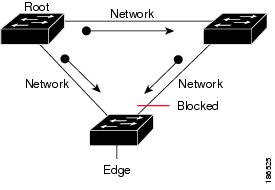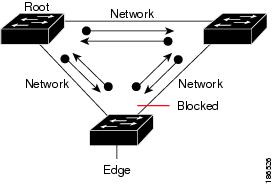- Cisco Community
- Technology and Support
- Networking
- Switching
- Thanks Paul. I configured the
- Subscribe to RSS Feed
- Mark Topic as New
- Mark Topic as Read
- Float this Topic for Current User
- Bookmark
- Subscribe
- Mute
- Printer Friendly Page
BPDU packets
- Mark as New
- Bookmark
- Subscribe
- Mute
- Subscribe to RSS Feed
- Permalink
- Report Inappropriate Content
06-12-2012 01:10 PM - edited 03-07-2019 07:12 AM
Hi
Are BPDU sent on all port of switch with any status or sent only some status?
On one switch with stp enable,we have 3 status for port,DP,BLK,Root. On Which status are BPDU sent ?
Thanks in advance
- Labels:
-
LAN Switching
- Mark as New
- Bookmark
- Subscribe
- Mute
- Subscribe to RSS Feed
- Permalink
- Report Inappropriate Content
06-12-2012 01:41 PM
BDPU are sent only on designated ports in a stable network. If you have bridge assurance enable, the switch will sent bpdu on all ports regardless of the state.
Normal STP

With Bridge Assurance

- Mark as New
- Bookmark
- Subscribe
- Mute
- Subscribe to RSS Feed
- Permalink
- Report Inappropriate Content
06-12-2012 01:44 PM
hi Nima,
bpdu's are sent out of the Root Bridge and are forwarded out of the root and designated ports. a port in the blocking state only receives bpdu.
plz Rate if it helped.
Soroush
Soroush.
- Mark as New
- Bookmark
- Subscribe
- Mute
- Subscribe to RSS Feed
- Permalink
- Report Inappropriate Content
06-13-2012 02:01 AM
Hi
dominic.caron and soroushm thanks a lot for your attention.
I have some mis-conception about BPDU.
1- Does only Root bridge generate BPDU packet for whole stp domain or another swtiches in stp domain generate BPDU?
2- Do Designated ports and Root ports on other switches recieve BPDU from peer switches ?
Thanks for any help or guidance
- Mark as New
- Bookmark
- Subscribe
- Mute
- Subscribe to RSS Feed
- Permalink
- Report Inappropriate Content
06-13-2012 02:18 AM
HI Nima,
I wanted to take a moment to comment on this because BPDU generation in RSTP is a topic that confuses a lot of people. So...here you go:
1. In 802.1d Spanning-Tree, only the Root Bridge was responsible creating/generating fresh BPDUs every Hello-Time (2-seconds by default). The Root Bridge would then transmit those new BPDUs on all of its Designated Ports. A downstream bridge that was directly-connected to the Root Bridge would receive those BPDUs on a port that might be either a Root Port or Blocking Port (if that downstream switch had an alternative path to the Root with a lower cumulative Cost).
----a. If a downstream bridge received those BPDUs on a Blocked Port, it would process the BPDU and then drop it. It could NOT forward that BPDU any further.
----b. If a downstream bridge received those BPDUs on a Root Port, it would process that BPDU, change the Sending Bridge-ID to it's own ID, update the "Root Cost" field, and then forward that BPDU out any Designated Ports it had.
2. In 802.1d, if the Root Bridge temporarily stopped sending BPDUs for a few seconds (maybe because it's CPU was spiked at 100%, or it was having memory shortage issues, yada, yada, yada) then you would notice that there were NO BPDUs anywhere in the switched topology for that duration of time. In other words, if you (as a non-Root bridge) didn't receive a BPDU, you had nothing to send to anyone else.
Please rate of it helps.
Regards
- Mark as New
- Bookmark
- Subscribe
- Mute
- Subscribe to RSS Feed
- Permalink
- Report Inappropriate Content
06-14-2012 10:48 PM
Hi again
Thanks a lot for your nice reply.
I have some misunderstanding about STP and BPDU:
1- Does any change(included disconnect cable or port shutdown) on switches of one STP domain result in STP process from scratch for election of root bridge and all phases for convergence of STP,as same as creating STP for first time ?
2- what does one switch do after receiving BPDU on portfast port?
3- what is minimum and maximum of STP convergence time ? Is it based on number of switch in STP domain?
Thanks for any help or guidance
Sent from Cisco Technical Support iPad App
- Mark as New
- Bookmark
- Subscribe
- Mute
- Subscribe to RSS Feed
- Permalink
- Report Inappropriate Content
06-15-2012 12:27 AM
Hi Nima,
Talking one quesiton at a time...
1- Does any change(included disconnect cable or port shutdown) on switches of one STP domain result in STP process from scratch for election of root bridge and all phases for convergence of STP,as same as creating STP for first time ?
Root Bridge election will happen only when the existing root goes down. Any link disconnect / port shutdown will not trigger the election of root bridge again.
2- what does one switch do after receiving BPDU on portfast port?
It depends on where you have enabled portfast. when portfast is enabled globally, that port will lose its portfast status and would start operating as normal STP port. But when the portfast is enabled on the interface mode, then since LIS/LRN stages are bypassed on the portfast enabled port, you may be at a risk of causing loop.
3- what is minimum and maximum of STP convergence time ? Is it based on number of switch in STP domain?
Well this depends on the time of failure.. generally , STP convergence will start from disabled -> Listening -> Learning -> Forwarding / Blocking.
Listening is 15 sec, Learning is 15 sec.
so convergence time is 30 seconds for a link to come in forwarding state. but this depends on the type of failure as well.
if it is an indirect link failure, it could be Max age (20)sec + Lis (15) sec + lear (15 ) sec = 50 sec delay.
HTH
-Vijay
- Mark as New
- Bookmark
- Subscribe
- Mute
- Subscribe to RSS Feed
- Permalink
- Report Inappropriate Content
06-15-2012 01:09 AM
Thanks for your reply.
So,if one link is disconnected or connected,what is happened for switches of STP domain?
Sent from Cisco Technical Support iPad App
- Mark as New
- Bookmark
- Subscribe
- Mute
- Subscribe to RSS Feed
- Permalink
- Report Inappropriate Content
06-15-2012 04:09 AM
When a link goes down / comes up, the switch generates TCN and send it on its root port towards the root bridge. all the switches towards the root will relay this towards the root bridge.
when the root bridge receives this , it sets the TCN Flag on its BPDU to "Yes" and send it across to all the switches downstream. so all the switches will set the CAM table aging timeout to forward delay (for the vlan's in which the failure was detected) and starts learning the CAM table again.
HTH
-Vijay
- Mark as New
- Bookmark
- Subscribe
- Mute
- Subscribe to RSS Feed
- Permalink
- Report Inappropriate Content
08-10-2015 09:02 PM
Hi, has anyone had problem with configuring bpduguard on a switchport which belong to a root bridge switch? I've been trying to apply bpduguard on a switch port on which the switch is root bridge, and i noticed it doesn't work. Is this the characteristic of bpduguard works?
PS: i applied the similar command on a non-rootbridge switch port, it works perfectly.
thanks for an reply.
- Mark as New
- Bookmark
- Subscribe
- Mute
- Subscribe to RSS Feed
- Permalink
- Report Inappropriate Content
08-10-2015 10:48 PM
I've been trying to apply bpduguard on a switch port on which the switch is root bridge, and i noticed it doesn't work. Is this the characteristic of bpduguard works?
In a stable network, the ports of a root bridge do no receive any BPDUs (at least in the "traditional" modes), so what you see is expected behavior.
However, when a port initializes e.g. after a status change, it depends on the STP mode. Since non-rapid modes do not perform the proposal/agreement sequence, there is a 50% chance that bpduguard won't detect a connected switch - depending on which switch sends the first BPDU.
HTH
Rolf
- Mark as New
- Bookmark
- Subscribe
- Mute
- Subscribe to RSS Feed
- Permalink
- Report Inappropriate Content
08-11-2015 08:34 PM
Thanks Rolf.
I agreed that the bpduguard take its action until some change in network. I've just tested and got more understanding.
Thanks for your reply and make me more clear about how it works.
- Mark as New
- Bookmark
- Subscribe
- Mute
- Subscribe to RSS Feed
- Permalink
- Report Inappropriate Content
08-11-2015 02:08 AM
Hello
How are you applying it - Globally or interface?
Globaly = bpduguard only works with portfast enabled ports
interface = bpduguard doesnt required portfast
res
Paul
Please rate and mark as an accepted solution if you have found any of the information provided useful.
This then could assist others on these forums to find a valuable answer and broadens the community’s global network.
Kind Regards
Paul
- Mark as New
- Bookmark
- Subscribe
- Mute
- Subscribe to RSS Feed
- Permalink
- Report Inappropriate Content
08-11-2015 08:31 PM
Thanks Paul.
I configured the bpduguard in interface mode.
Find answers to your questions by entering keywords or phrases in the Search bar above. New here? Use these resources to familiarize yourself with the community:
